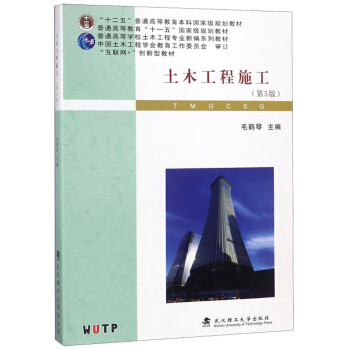土木工程专业英语 / 高等学校土木工程专业卓越工程师教育培养计划系列规划教材
作者: 吴轶
出版时间:2015年10月
出版社:湖北开动传媒科技有限公司
- 湖北开动传媒科技有限公司
- 9787307159952
- 65682
- 0047168730-1
- 2015年10月
- TU
- 土木工程
- 本科
本书选材涉及土木工程概况、土木工程类别、土木工程材料、工程荷载及作用、结构构件类别、地下工程、桥梁工程、道路工程、工程抗震设计、隔震技术、建筑加固技术等方面,共分为13章,每章均由课文、生词和短语组成。在内容上,涉及工程材料、材料力学、理论力学、混凝土结构设计原理、钢结构设计原理、道路工程、结构抗震设计、建筑加固理论、土力学、基础工程等相关学科知识。
Chapter 1 Overview of Civil Engineering
1.1 Introduction of Civil Engineering
Section A The Origin of Civil Engineering
Section B What Is a Civil Engineer
1.2 The Importance of Civil Engineering
Section A The Role of Civil Engineering in Society
Section B Historic Civil Engineering Landmarks
References
Chapter 2 Types of Civil Engineering
2.1 Structural Engineering
Section A Introduction of Structural Engineering
Section B Basic Types of Structures
2.2 Bridge Engineering
2.3 Underground Engineering
Section A Introduction of Metropolitan Railway
Section B Introduction of Tunnel Engineering
2.4 Road Engineering
Section A Introduction of Road Engineering
Section B Maintenance of Road Engineering
References
Chapter 3 Materials of Civil Engineering
3.1 Concrete
Section A Introduction of Concrete
Section B Properties of Concrete
3.2 Steel
3.3 Masonry
References
Chapter 4 Loads and Actions in Civil Engineering
4.1 Dead Load and Live Load
4.2 Wind Load and Wind Damage
Section A Introduction of Wind Load
Section B Classification of Wind Load
Section C Horizontal Wind Loads and Roof Wind Loads on Structural Frames
Section D Wind for Components and Wind Damage
4.3 Earthquake Action and Damage
Section A Earthquake Action
Section B Earthquake Damage
4.4 Tsunami Damage to the Structure of Civil Engineering
Section A Tsunami Damage
Section B Tsunami Damage to Buildings
Section C Resistance of Tsunamis for Structures
References
Chapter 5 Members of Civil Engineering
5.1 Horizontal Forced Structural Members
Section A Introduction of Beam
Section B Forces within a Beam
Section C Shear Strength and Parameters
Section D Coupling Beams
Section E Flat Plates
Section F Behavior of Concrete Slabs
Section G Floor Framing Systems
5.2 Vertical Forced Structural Members
Section A Introduction of Column
Section B Increasing Compressive Strength
Section C High-strength Steel in Concrete Columns
Section D Confinement in Reinforced Concrete Columns
Section E Introduction of Concrete Structural Wall
Section F Behavior of Structural Wall
Section G Steel Plate Shear Walls
5.3 Arch
Section A Introduction of Arches
Section B Development of Arch Bridges
5.4 Truss
Section A Introduction of Truss
Section B Analysis of Internal Force
Section C Production and Installation of a Truss
References
Chapter 6 Basic Types of Engineering Structure
6.1 Reinforced Concrete Structures
Section A Application of Reinforced Concrete Structures
Section B Performance of Reinforced Concrete Structures
6.2 Steel Structure
Section A Introduction of Steel Structures
Section B Incheon International Airport
6.3 Classification of Steel Concrete Composite Structure
Section A Steel Concrete Composite Structure
Section B Concrete-filled Steel Tube Column
6.4 The Modern Complex High-rise Building Structure
Section A Performance-based Seismic Design
Section B Performance Objectives of PBSD
References
Chapter 7 Bridge Engineering
7.1 Introduction of Bridge Engineering
Section A History of Bridge
Section B London Millennium Footbridge
7.2 Classification of Bridge
Section A Rigid Beam and Cantilever
Section B Suspension and Arch
7.3 Design of Bridge
Section A Design of Bridge Structure
Section B Numerical Analysis of Bridge Structures
References
Chapter 8 Underground Engineering
8.1 Introduction of Underground Engineering
Section A Exploitation of Underground Space
Section B The Underground Strategy
8.2 Underground Tunnel Engineering
Section A Tunneling Risk
Section B A New Requirement of Tunneling
8.3 Development of Underground Space Structure
Section A Web-based Shield Tunnel Construction Information












